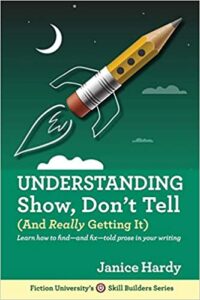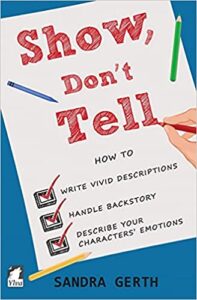Show; don’t tell is the piece of advice writers and authors, at any stage of their career may give or get. This advice is correct up to a certain level.
If a book shows everything, the number of details bores the reader. On the other hand, if a story fills only with tells, it is not a story at all. It is a piece from a Wikipedia article or a newspaper article.
Too much SHOW is as bad as too much TELL
I read another piece of advice somewhere that I believe is worth giving to you.
Choose what to show
There is no rule to tell us where to find the balance. It depends on the art and the craft of the storyteller!
To decide consciously between show and tell, at first, we need to recognize tells. And, here comes the first problem. I didn’t know exactly where my writing is a tell and when it is a show. Some obvious red flags help but, honestly, I didn’t have a deep understanding of this subject.
This blog post is a summary of my research and learnings on how to recognize a tell from a show.
I read many blog posts and craft books on this subject. Understanding Show, Don’t Tell: And Really Getting It (2016) by Jance Hardy is the best book I found. Even though the book is a bit wordy and repetitive, the time is definitely well spent.

Another good book is Show, don’t Tell (2018) by Sandra Gerth. This book reviews pitfalls and suggests some solutions. However, if you want just to read one book, I suggest the above one.

Levels of Tell
In her book (Understanding Show, Don’t Tell: And Really Getting It), Jance Hardy divided tell into three levels and this is the most accurate way to investigate tell and show that I have found so far:
- The sentence level
- The paragraph level
- The scene level
Perhaps in writing picture books, we mainly ought to deal with the tells at the sentence level. Having said this, let’s discuss the three levels.
Sentence-level tells
Here is a summary of six types of tellings in the sentence level.
- Motivational tells
- Emotional tells
- Mental tells
- Stage direction
- Descriptive tells
- Passive tells
Now, let’s move to discuss them one by one.
Motivational tells
This type of tell happens when Narrator explains a character’s motivation. Some red flag words are to [verb], when, because, decided, tried.
A general tip to fix this is that if an outside observer who is watching the action can correctly guess the motivation, the Narrator doesn’t need to clarify the motivation!
The second tip is to show the action, not tell the intention. For example:
To try could have several different meanings: to struggle, to fail, or to succeed. If it is a struggle, then show it. If it is a struggle, show it.
The same discussion is valid for WHEN.
Emotional tells
This type of tells explains feelings.
This is the most frequent type of telling and the most harmful one. Showing emotions is the opportunity to engage the reader’s feelings with the story and when a story tells the emotion, it loses this chance.
To fix the emotional tells considering two points are helpful. First, our emotions affect our hormones and therefore, our body. For example, a child is bullied in school and this made him angry. If you explain that bullying situation and then say that the child’s face became red, I get the child’s feeling. In picture books, it is even more straightforward: the illustration shows the red face. Thus, only explain the bullying situation and discard the ‘he was angry’ sentence.
Second, our feelings cause reactions. It is our biological response to hormones. An angry child doesn’t stand and watch. He might shout, or cry, or clenches his hand into a fist! There should be a reaction. And remember that some reactions could be illustrated! So, again, only describe the bullying scene.
Mental tells
This type of tells explains what the character thinks. Some red flag verbs are to realize, to hope, to wonder, to consider, to know, to believe. Mental tells, in most cases, (a) lessen the emotional impact of the key scene, and (b) leave nothing for the reader to wonder about.
The general guide to fixing this type of telling is to let the reader figure out what is going on in the character’s head. Here is a good example I took for the aforementioned reference (page 80).
Now, compare with this one:
Did you notice the difference? The latter has a more tight point of view and it is closer to the character than the first one. The reader understands the character’s favorite food herself!
Stage direction tells
This type of tell is when the author describes events. Some red flag words are As, by, when (directional), before, after, since.
It is a tell when the author knows what is going to happen to the character and describes the scene with this knowledge. Yet, the character still hasn’t faced the event. For example:
If you put yourself in the character’s shoes(the teacher) and see the scene from her eye, you notice the mistake. The teacher couldn’t know the classroom was empty before she entered. The author knew, but not the character!
Another red flag word is AS. As means that two actions happen simultaneously. Using AS in explaining some scenes could be logically wrong. Take the above sentence as an example.
It cannot be correct if you walk in the teacher’s shoes!
The same discussion is valid for BY, BEFORE, and AFTER. The character unfolds events in chronological order. The reader enjoys the story if we narrate the events in the same order as the character’s experience, not all at once!
Descriptive tells
This type is the most frequent type of the tells because it happens when the writer explains the sensory details (sight, touch, sound, taste, and smell) and puts her words in the head or mouth of the Narrator. Thus, the easiest way to spot a descriptive tell is to look at who is describing the scene: The author or the story’s Narrator?
Passive tells
‘Eliminate passive verbs’ is one of the revision advice you have heard for sure. If you use ProWriting aid or Grammarly, they keep reminding remove passive verbs. First of all, the passive verbs aren’t useless. Consider this example: ‘she was given a list of equipment she needs.’ A general rule cannot dictate whether to remove this sentence or not. If having the list is the priority and it doesn’t matter who gave the character the list, then the passive sentence is fine. But, let’s suppose the person who gave the list had removed some items from the list on purpose, then it matters to the reader to know the name of that person. Thus, the story needs an active verb, rather than a passive one.
Paragraph-level tells
Spotting a paragraph that is told, not shown, is more difficult than finding such a thing in sentences. The biggest damage of this type of tells is that they don’t develop the plot and slow down the story’s pace. These paragraphs lack emotional content and, therefore, don’t connect with the reader!
The paragraph telling can happen in two different categories: infodump paragraphs and backstory paragraphs. Even though infodump and backstory are usually used interchangeably, they are different. Infodump explains the story’s world while the backstory informs the reader of the history of the character and why this character became who he/she is today.
It should be noted that in some genre, like historical fiction (or biography), science fiction, and fantasy fiction, the infodumps seems unavoidable. The setting and the story’s world need explanation. However, this could be minimized.
In studying picture books, I mainly noticed infodumps and backstory tells in the picture book biographies, especially cradle-to-grave biographies. Birth information and childhood are most often told backstories.
While researching, my question was what to do with the back stories? Is there any way to mitigate the effect of backstories in picture book biographies? Among the blog posts I found, this post offered three thoughtful suggestions. Here are the suggestions:
- Is this information essential for the story?
For instance, does it help to know which jobs the character’s parents have? Or, which college did she go to? You can justify that each life event has an impact on the character’s personality and therefore it’s worth mentioning. However, a picture book biography has not enough place for all events.
Second, the aim is to make a story (which has a Narrative Structure), not fit everything into the book! To examine the importance of a piece of information while reading a picture book biography, I ask myself if I don’t read this paragraph (or this spread) would I miss the story’s track? Then I ask myself, how did this spread develop the story?
‘Be ruthless’ is the best advice I found about the infodumps and backstory tells. Hours and hours are spent on gathering material to write a picture book biography and discarding the information isn’t easy. But, to have a statute some pieces of the stone should be cut!
The best practice is to start from other people’s manuscripts. Because I don’t have any emotional association with other people’s books and manuscripts but I have with mine!
Now, let’s deal with the boiled-down list of information. How to show them?!
- How can I get the character to show some information?
It is a brilliant suggestion and since I read it I am thinking about an example in a published picture book biography. I haven’t found any
- If the information is necessary, how can I use it to enhance the emotional effect of the scene?
I copied this example from the aforementioned blog post. It is more for adult books, rather than picture books. Nevertheless, it gives you a rough idea.
Scene-level tells
The scene-level telling isn’t applicable to picture books. However, for the sake of completeness, I added it here.
This type of telling is similar to the last one. Besides backstory and infodump, the scenes with flashback tell are another red flag. It could be the scene is shown but they are still a tell. They tell the reader what happened!
I write blog posts about the craft of writing picture books regularly. The list of the previous posts is on the PictureBookPedia. Also, I publish a quarterly newsletter that includes links to my recent blog posts. The next newsletter will be on 01.07.2022. The form you have selected does not exist.

